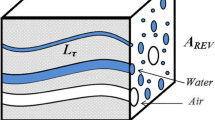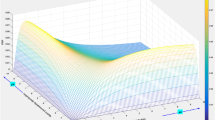In this paper the fractal theory is used to derive formulas for calculating seepage velocity, permeability, and porosity for the flow of/kids in porous media with dual fractal dimensions (capillary diameter and capillary distortion fractal dimension). The dual fractal model is applicable for most limestone reservoirs. It is shown that the percolation equation of micro-compressible fluids, or the double fractal pressure diffusion equation, is a partial differential equation. The equation is solved for the pressure drop and pressure recovery conditions. The solutions for the actual wellbore consider wellbore storage and skin Wen parameters, and a model curve of an infinite reservior is drawn. Analysis of the double fractal media shows that the traditional well test analysis methods, like the pressure drop semi-log linear curve method, pressure recovery Horner method, and Gringarten-Bourdet diagram method will bring great errors, especially when the distortion fractal dimension is large. Using the established well test model, the parameters of the limestone oil reservoir and the unstable pressure data are measured, and the accurate oil reservoir effective permeability, fractal length, and fractal dimensions are calculated.




Similar content being viewed by others
References
J. Chang and Y. C. Yortsos, “Pressure transient analysis of fractal reservoirs,”SPEFE,5(1), 31-38 (1990).
J. A. Acuna and Y. C. Yortsos, “Practical application of fractal pressure transient analysis in naturally fractured reservoirs,”SPEFE, 10(3), 173-129 (1995).
Cigna Liu, “Fractal reservoir pressure dynamic characteristics,” Oil Gas Well Test., 5(1), 1-3 (1996).
F. Li, C. Liu, and F. Song, “The application of fractal in the development of oil and gas fields,”Adv. in Mech., 28(1), 101-110 (1998).
D. Tong and Y. Wang, “Application of fractal theory in flow analysis of porous media,” J. China Univ. Sci. Technol., 34 (Supplement), 257-262 (2004).
K. Xiang, X. Xie, and G He, “Seepage mathematical model and analytic solution of deformed double media fractal reservoir,” J. China Univ. Sci. Technol., 34 (Supplement), 63-38 (2004).
S. Li, P. Zhen, and Y. Zhang, Similar Structure of Well Test Analysis in Fractal Reservoir, Resource Environment and Seepage Mechanics, Proceedings of the 8th Symposium on Percolation Mechanics, China Science and Technology Press, Beijing (2005).
A.J. Katz and A.H. Thompson, “Fractal sand store pore: implications for conductivity and pore formation,” Phys. Rev. Let., 54, 1325-1328 (1985).
P.M. Adler and J.F. Thovert, “Fractal porous media,” Transp. Porous Media, 13, 41-78 (1993).
B.B. Mandelbrot, Fractal Geometry of Nature, Freeman. New York (1982).
P.C. Carman, “Fluid flow through a granular bed,” Trans. Inst. Chem. (London), 15, 150-156 (1937).
B. Wooden et al., “Well test analysis benefits from new method of Laplace space inversion,” Oil Gas J., 7(20), 108-120 (1992).
H. Stehfest, “Well test analysis benefits from new method of Laplace space inversion,” Commun. ACM, 13(1), 47-49 (1970).
Li Jingsheng, Porous Media Fluid Dynamics, China Building Industry Press, Beijing (1984).
Acknowledgments
This work is funded by National Natural Science Foundation of China: Research on the microscopic flow law of polymer flooding based on molecular dynamics (Grant No. 51874241), the study on apparent permeability of viscoelastic polymer flooding based on molecular dynamics simulation (Grant No. 2018J155054), and the multi-scale and multi-mechanism coupled seepage model of volume fracturing horizontal well based on boundary element method in tight oil reservoir (Grant No. 51804258).
Author information
Authors and Affiliations
Corresponding author
Additional information
Translated from Khimiya i Tekhnologiya Topliv i Masel, No. 6, pp. 79 — 85, November —December, 2019.
Rights and permissions
About this article
Cite this article
Xu, J., Ren, Z., Vane, D. et al. Method of Fractal Reservoir with Irregular Crack Bedrock System and Its Application for Well Test Analysis. Chem Technol Fuels Oils 55, 778–789 (2020). https://doi.org/10.1007/s10553-020-01093-y
Published:
Issue Date:
DOI: https://doi.org/10.1007/s10553-020-01093-y




